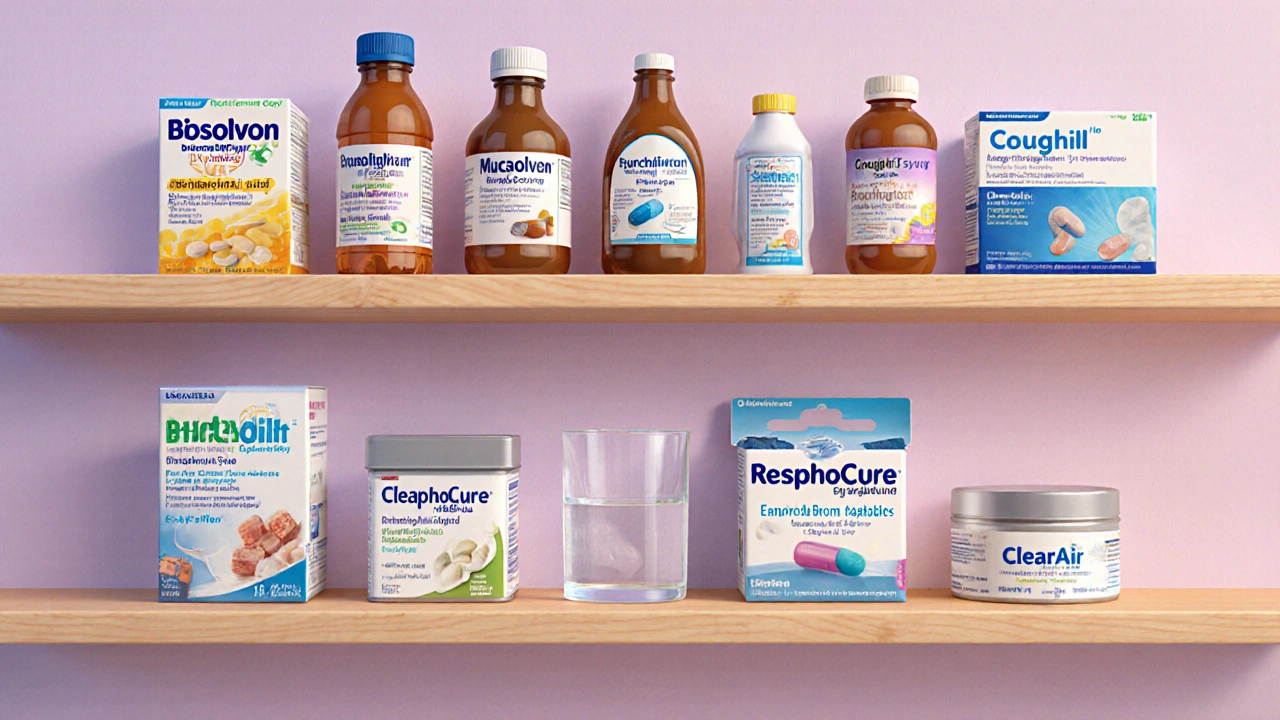
Top 10 Bromhexine Medicines for Cough and Respiratory Relief
Discover the top 10 bromhexine medicines for cough relief, compare their forms, strengths, and prices, and learn how to pick the right one for your respiratory needs.
When you hear about bromhexine, a synthetic mucolytic used to thin thick mucus in the respiratory tract. Also known as Bisolvon, it helps clear airways and ease coughing. Bromhexine belongs to the broader group of mucolytic agents, which are medicines that break down the structure of mucus so it can be expelled more easily. Because it reduces mucus viscosity, bromhexine is often paired with cough the body’s reflex to clear irritation from the throat and lungs and is a common choice for treating bronchitis, an inflammation of the bronchial tubes that leads to persistent cough and mucus buildup.
Why does bromhexine matter for anyone dealing with a chest infection? First, its active ingredient stimulates the serous cells in the airway lining, increasing the production of thin, water‑rich secretions. Second, it modifies the structure of existing mucus, breaking down the long chains of glycoproteins that make it sticky. The result is a two‑step effect: easier expectoration and less irritation, which means a calmer cough. In practice, patients notice less nighttime coughing, clearer breathing, and quicker recovery from illnesses like acute bronchitis or chronic obstructive pulmonary disease (COPD). That's why doctors often rank bromhexine among the best bromhexine drugs for treating mucus‑related respiratory problems.
Not all bromhexine preparations are identical. Some come as tablets, others as syrups, lozenges, or even inhalable solutions. The dosage form matters because it influences how fast the drug reaches the lungs and how convenient it is for the patient. For example, syrups are popular for children and people who have trouble swallowing pills, while tablets suit adults who prefer a quick, once‑daily dose. Combination products also exist, pairing bromhexine with other agents like guaifenesin or paracetamol to address both mucus thinning and pain or fever. When choosing a product, think about the following attributes: dosage strength (usually 8 mg per tablet), frequency of administration (often three times daily), and whether you need an added analgesic or decongestant.
Another aspect is the brand reputation and regulatory approval. In many countries, bromhexine is available over the counter, but the quality can vary. Look for products that list the exact amount of bromhexine per dose and have clear expiration dates. Trusted manufacturers usually provide a brief description of the drug’s mechanism and any contraindications, such as avoiding use in severe liver disease or known hypersensitivity. Checking the packaging for a proper pharmacy seal can also save you from counterfeit versions that might lack the active ingredient.
Side effects are generally mild, but they’re worth mentioning. The most common complaints are a transient metallic taste, mild gastrointestinal upset, or rare skin rashes. Because bromhexine works locally in the throat and lungs, systemic side effects are uncommon. However, if you have a history of ulcer disease or are taking other mucolytics, it’s smart to consult a pharmacist or doctor before adding a new product.
Now, how does bromhexine stack up against other mucolytic agents like N‑acetylcysteine (NAC) or carbocisteine? The main difference lies in the way each drug alters mucus. NAC breaks disulfide bonds in mucus proteins, while carbocisteine modifies the synthesis of mucus. Bromhexine, on the other hand, stimulates serous cell activity and reduces mucus viscosity without significantly changing mucus production. In comparative studies, patients often report faster relief of cough with bromhexine, especially when the mucus is thick and sticky. That makes it a go‑to option for acute episodes, whereas NAC is sometimes preferred for chronic conditions like cystic fibrosis.
Finally, think about accessibility and cost. Generic bromhexine tablets are usually cheap, making them an affordable choice for long‑term use. Syrups and combination packs can be a bit pricier, but the added convenience for children or the extra symptom relief they provide can be worth the extra pennies. Online pharmacies often list price comparisons, but always verify that the seller is licensed to avoid counterfeit products.
Below you’ll find a curated list of articles that dive deeper into specific bromhexine brands, dosage guidelines, side‑effect management, and how these drugs compare with other cough and bronchitis treatments. Whether you’re looking for a quick fix for a seasonal cough or a reliable option for chronic mucus issues, the posts ahead will give you the details you need to make an informed choice.

Discover the top 10 bromhexine medicines for cough relief, compare their forms, strengths, and prices, and learn how to pick the right one for your respiratory needs.